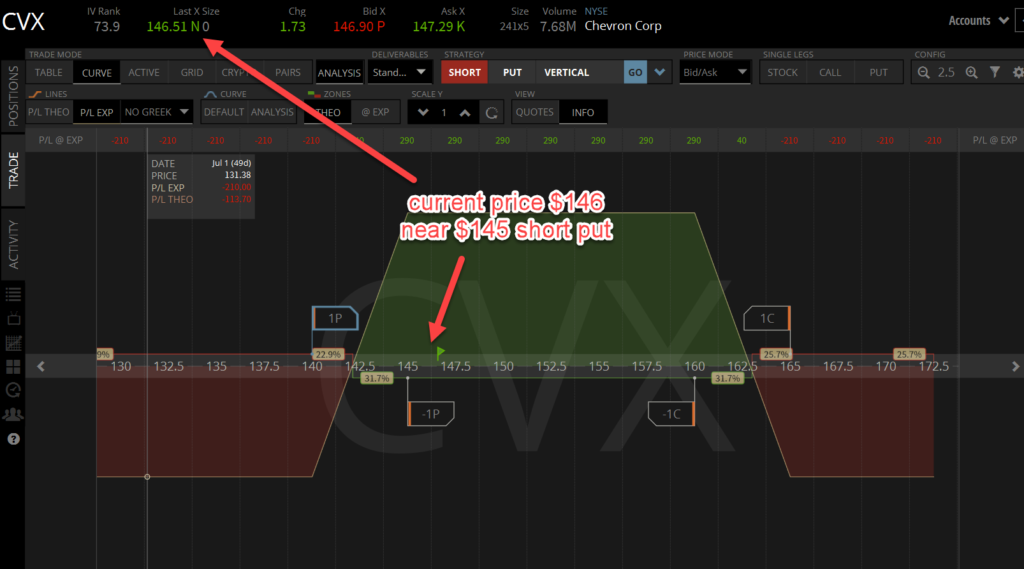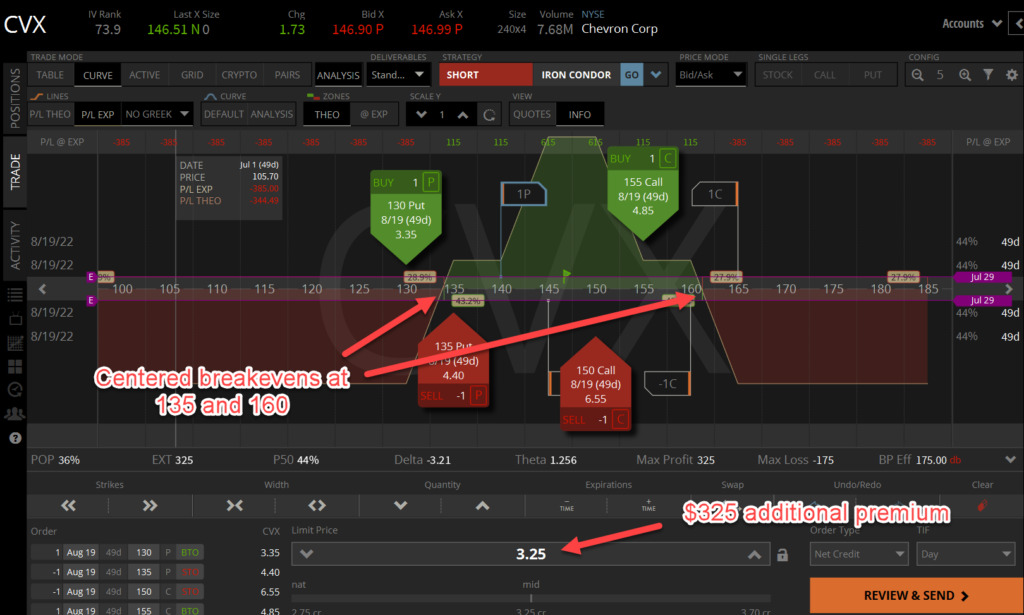
There is no doubt that the stock market can be a volatile place. This volatility can work in your favor or against you, depending on the type of trader you are. If you are looking to profit in a volatile market, then one strategy you may want to consider is layering Iron Condors. In this blog post, we will discuss the advantages of layering Iron Condors and how you can use this strategy to make money in any market condition!
We discuss:
- What Is An Iron Condor?
- When Should You Use Iron Condors?
- What Are The Advantages Of Layering Iron Condors?
- What Are The Risks Of Using Iron Condors?
- How Many Iron Condors Should You Layer?
- How Do You Layer Iron Condors? A Real-World Example
- How Should You Manage Iron Condors?
- Conclusion
What Is An Iron Condor?

An Iron Condor is a directionally neutral, defined risk strategy that profits from a stock trading in a range through the expiration of the options. It benefits from the passage of time and any decreases in implied volatility.
It is constructed by holding one long put and one short put with different strike prices, and also holding one long call and one short call with different strike prices.
The different strike prices will create 4 different “legs” or options contracts.
Directional Assumption: Neutral
Setup:
– Sell OTM Call Vertical Spread
– Sell OTM Put Vertical Spread
Ideal Implied Volatility Environment: High
Max Profit: The maximum profit potential for an Iron Condor is the net credit received. Maximum profit is realized when the underlying settles between the short strikes of the trade at expiration.
How to Calculate Breakeven(s):
– Upside: Short Call Strike + Credit Received
– Downside: Short Put Strike – Credit Received
When Should You Use Iron Condors?
An Iron Condor options strategy should be utilized when the investor feels that the underlying will stay within a defined trading range. And as mentioned above, it is best utilized when volatility is high. This is because the option premium collected is greater when volatility is higher.
What Are The Advantages Of Layering Iron Condors?
Layering Iron Condors can be a great strategy to use if you are looking to profit in a volatile market. By layering Iron Condors, you are essentially increasing your chances of making money while also diversifying your risk.
I like to start with placing one contract and allowing it to run until it reaches 50% of max profit. If the trade goes against me, then I go ahead and manage the untested side.
When I’m at the point of having to manage an Iron Condor option trade, this is the time that I look to place my second Iron Condor trade in the same underlying at new strike prices centered around the current price.
While the existing trade may be a loser, the new trade will likely help to balance out the trade at the new strike prices. This allows you to collect additional option premium to decrease your loss or increase profit.
If the market is volatile, you can profit from the increased premium collected from selling iron condors. If the stock underlying stays range-bound, you can profit from the time decay.
Another advantage of using this strategy is that it provides defined risk. You know exactly how much you can lose before entering the trade.
This strategy is relatively easy to set up and manage. Once you have constructed your Iron Condor, all you need to do is monitor the underlying and make adjustments as needed.
What Are The Risks Of Using Iron Condors?
As with any option strategy, there are risks when trading iron condors. The biggest risk to iron condors occurs when the stock underlying moves outside of the expected range. This can happen for a variety of reasons, such as an earnings report or a change in the overall market sentiment. If this happens, you will likely lose money on your trade.
How Many Iron Condors Should You Layer?
When using stock options it is important to stay small so that we do not blow up. A good rule of thumb is to not risk more than 3-5% on any one trade. Of course, it depends on the size of your account. This is called “position limit”. A smaller account will not have the luxury of using as many trades. This way if we do have a losing trade it will not have a large impact on our account.
So to stay at less than 5% in each underlying, we can back trace and determine the max number of iron condor contracts that we can use in a given monthly cycle. For example, if we have a $50,000 account and use the following assumptions:
$50,000 x 0.03 = $1500 (this is our max risk per underlying)
$1500/5 = 3 contracts (this is the max number of contracts per underlying) if the buying power per contract is $500.
How Do You Layer Iron Condors? A Real-World Example
Now that we know the advantages and risks of using Iron Condors, as well as how many contracts we can use, let’s take a look at an example of how to layer Iron Condors.
For our example, we will use the following underlying stock: CVX. We put the iron condor on when the price was around $152. We sold the 140/145 put spread and the 160/165 call spread. We collected $290 when we put this trade on which is the max profit at expiration.

Now that the stock is testing our short put spread we can roll down the call spread or we can layer and place another iron condor.
Let’s place another iron condor centered around the current price to bring our profit zone back to centered.

So we well the 135/135 put spread and the 150/155 call spread which is a little delta negative. However overall this makes us neutral and we collect another $325 in option premium. We now stay in the profit zone between 135 and 160 with the current price at 146.
How Should You Manage Iron Condors?
I like to put on Iron Condors with about 30-45 DTE days to expiration. I look to close the trade out completely when 50% profit is reached.
I like to manage Iron Condors when one of the short strikes is breached or tested. We manage iron condors by adjusting the untested side, or profitable side of the spread. To do this, we roll the untested spread closer to the stock price to collect more premium. We can go as far as rolling our untested spread to the same short strike as our tested spread, which creates an iron fly.
When I’m at the point of having to manage an Iron Condor option trade, this is the time that I look to place my second Iron Condor trade in the same underlying at new strike prices centered around the current price.
While the existing trade may be a loser, the new trade will likely help to balance out the trade at the new strike prices. This allows you to collect additional option premium to decrease your loss or increase profit.
When we get to the 15-21 DTE days to expiration, then I like to close out all of the positions and move out the next month re-centering. Of course, this is only if IVR is still high so that good premium may be collected.
Conclusion
In conclusion, layering Iron Condors can be a great way to profit in a volatile market. By layering Iron Condors, you are essentially increasing your chances of making money while also diversifying your risk. When using this strategy, it is important to stay small and not risk more than you can afford to lose.
As you can see, by layering our Iron Condors we have increased our chances of making money while also diversifying our risk.
If you are looking to profit in a volatile market, then Layering Iron Condors is a great strategy to use!
Learn about how to utilize all of the other options strategies HERE!
Happy trading!